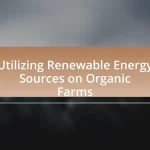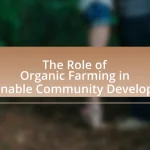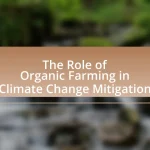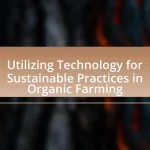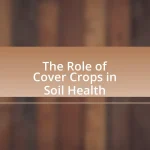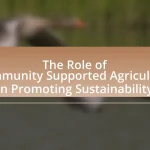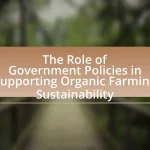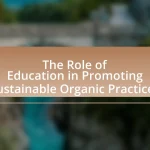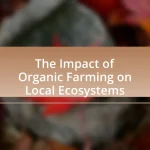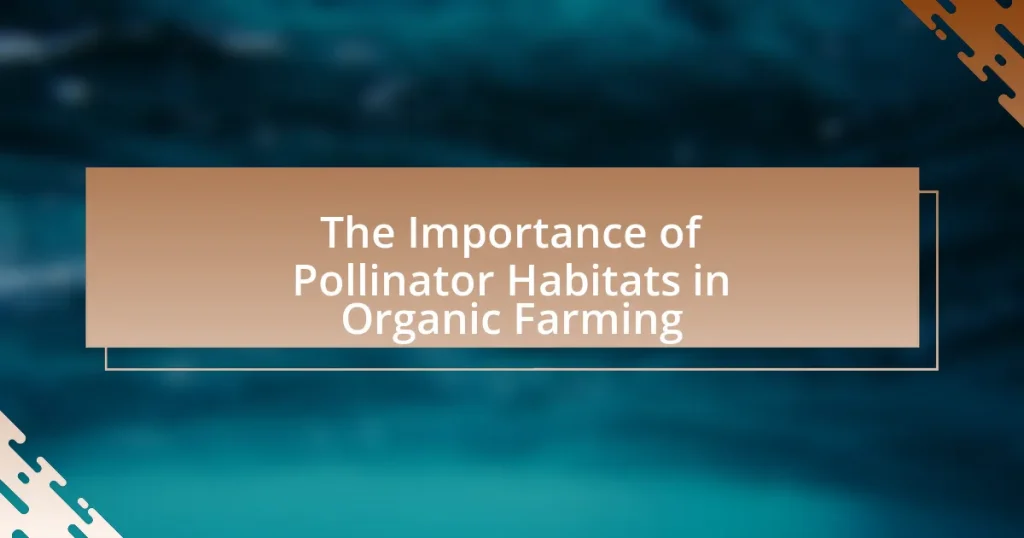Pollinator habitats are essential environments that provide food, shelter, and nesting sites for pollinators such as bees and butterflies, playing a critical role in organic farming. These habitats enhance biodiversity, improve crop yields by up to 50%, and promote ecosystem health by supporting plant reproduction and soil vitality. The article explores the types of plants necessary for effective pollinator habitats, the challenges these habitats face, and practical steps organic farmers can take to support them. Additionally, it highlights the economic advantages of healthy pollinator populations and their contribution to sustainable agricultural practices.
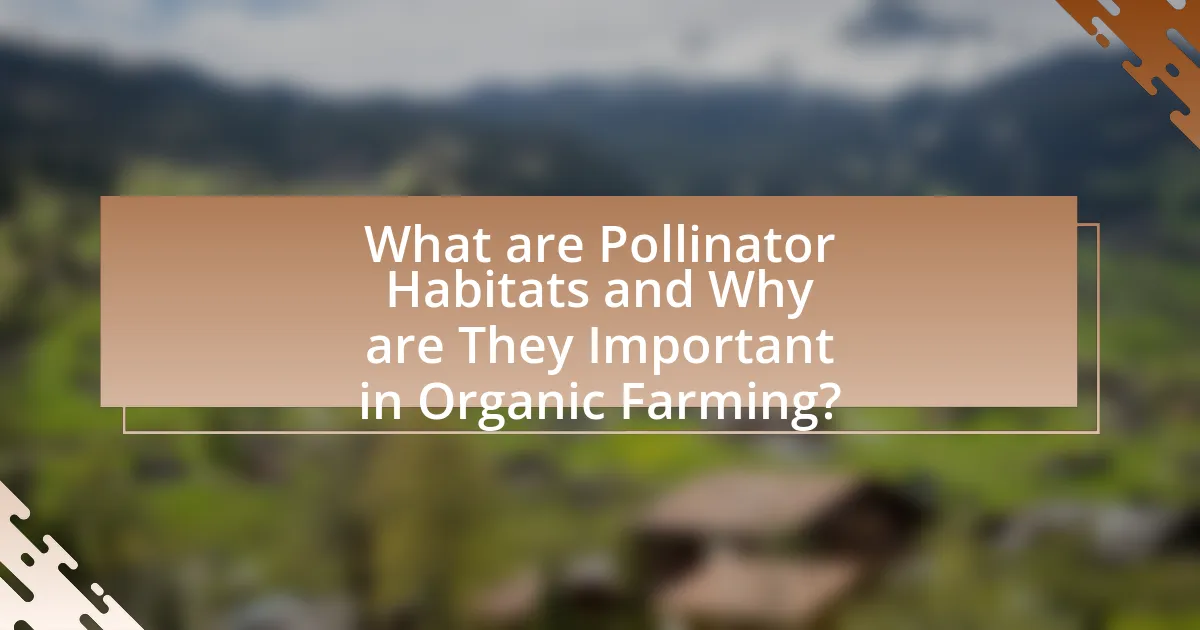
What are Pollinator Habitats and Why are They Important in Organic Farming?
Pollinator habitats are environments that provide food, shelter, and nesting sites for pollinators such as bees, butterflies, and other insects. These habitats are crucial in organic farming because they enhance biodiversity, improve crop yields, and promote ecosystem health. Research indicates that farms with diverse pollinator habitats can experience up to a 50% increase in fruit and seed production due to improved pollination services. Additionally, pollinator habitats contribute to soil health and pest control, further supporting sustainable agricultural practices.
How do Pollinator Habitats Support Biodiversity in Organic Farming?
Pollinator habitats support biodiversity in organic farming by providing essential resources for pollinators, which in turn enhance the variety of plant species and improve ecosystem resilience. These habitats offer food sources, such as nectar and pollen, and nesting sites for various pollinator species, including bees, butterflies, and other insects. Research indicates that farms with diverse pollinator habitats can increase crop yields by up to 50%, as pollinators facilitate the reproduction of flowering plants, leading to greater genetic diversity. Additionally, a study published in the journal “Ecological Applications” by Garibaldi et al. (2013) found that the presence of pollinators significantly boosts the productivity of organic farms, demonstrating the critical role of pollinator habitats in maintaining biodiversity and supporting sustainable agricultural practices.
What types of plants are essential for creating effective Pollinator Habitats?
Native flowering plants, such as milkweed, coneflower, and bee balm, are essential for creating effective pollinator habitats. These plants provide nectar and pollen, which are crucial food sources for various pollinators, including bees, butterflies, and hummingbirds. Research indicates that diverse plant species enhance pollinator abundance and diversity, as they bloom at different times throughout the growing season, ensuring a continuous food supply. For instance, a study published in the journal “Ecological Applications” found that landscapes with a variety of native plants supported higher populations of pollinators compared to those with limited plant diversity.
How do Pollinator Habitats contribute to ecosystem health?
Pollinator habitats significantly enhance ecosystem health by providing essential resources for pollinators, which are crucial for plant reproduction. These habitats support biodiversity by fostering a variety of plant species that rely on pollinators for fertilization, thereby maintaining genetic diversity and ecosystem resilience. Research indicates that areas with rich pollinator habitats can increase crop yields by up to 30%, demonstrating their vital role in agricultural productivity and food security. Furthermore, healthy pollinator populations contribute to the stability of ecosystems by supporting food webs and promoting soil health through the growth of diverse plant life.
What Role do Pollinators Play in Organic Farming?
Pollinators play a crucial role in organic farming by enhancing crop yields and promoting biodiversity. They facilitate the reproduction of flowering plants through the transfer of pollen, which is essential for the production of fruits, seeds, and vegetables. Research indicates that approximately 75% of the world’s food crops depend on animal pollination, highlighting the significance of pollinators in agricultural systems. In organic farming, where synthetic pesticides and fertilizers are minimized, the presence of pollinators contributes to healthier ecosystems and sustainable agricultural practices. Studies have shown that farms with diverse pollinator habitats can experience up to a 50% increase in crop yields, demonstrating the direct impact of pollinators on organic farming productivity.
Why are pollinators critical for crop production in organic systems?
Pollinators are critical for crop production in organic systems because they enhance the yield and quality of fruits, vegetables, and nuts through effective pollination. Studies indicate that approximately 75% of the world’s flowering plants and about 35% of global food crops depend on animal pollinators, including bees, butterflies, and birds. In organic farming, where synthetic pesticides and fertilizers are minimized, the reliance on natural pollination becomes even more significant, as it directly influences biodiversity and ecosystem health. Research published in the journal “Agriculture, Ecosystems & Environment” highlights that farms with diverse pollinator habitats can experience up to a 50% increase in crop yields compared to those with limited pollinator access. This demonstrates the essential role of pollinators in sustaining organic agricultural productivity.
How do pollinators affect the quality and yield of organic crops?
Pollinators significantly enhance the quality and yield of organic crops by facilitating the process of pollination, which is essential for the reproduction of many flowering plants. Studies indicate that crops such as fruits, vegetables, and nuts benefit from increased pollinator activity, leading to higher fruit set and improved seed development. For example, research published in the journal “Agriculture, Ecosystems & Environment” found that farms with diverse pollinator populations can experience yield increases of up to 50% compared to those with fewer pollinators. Additionally, the presence of pollinators contributes to the nutritional quality of crops, as pollinated plants often produce larger and more uniform fruits, which are more appealing to consumers. Thus, the role of pollinators is critical in optimizing both the quantity and quality of organic crop production.
What Challenges do Pollinator Habitats Face in Organic Farming?
Pollinator habitats in organic farming face several significant challenges, including habitat loss, pesticide exposure, and climate change. Habitat loss occurs due to agricultural expansion and land development, which reduces the availability of diverse flowering plants essential for pollinators. Pesticide exposure, even in organic farming, can occur through drift from neighboring conventional farms, negatively impacting pollinator health. Climate change alters the timing of flowering plants and pollinator activity, disrupting their mutual dependencies. Research indicates that these factors collectively threaten the stability and health of pollinator populations, which are crucial for the success of organic farming systems.
What are the main threats to pollinator populations in agricultural settings?
The main threats to pollinator populations in agricultural settings include pesticide use, habitat loss, and climate change. Pesticides, particularly neonicotinoids, have been shown to negatively impact pollinator health and behavior, leading to population declines. Habitat loss due to monoculture farming practices reduces the availability of diverse food sources and nesting sites for pollinators. Additionally, climate change alters flowering times and disrupts the synchrony between pollinators and plants, further threatening their survival. Studies indicate that these factors collectively contribute to the decline of pollinator species essential for crop pollination and ecosystem health.
How can organic farmers mitigate these threats to protect pollinators?
Organic farmers can mitigate threats to pollinators by implementing diverse crop rotations, maintaining hedgerows, and avoiding synthetic pesticides. Diverse crop rotations enhance habitat variety and food sources for pollinators, while hedgerows provide shelter and nesting sites. Additionally, the avoidance of synthetic pesticides reduces harmful exposure to pollinators, as studies show that neonicotinoids, a common class of pesticides, have been linked to pollinator decline. By adopting these practices, organic farmers can create a more supportive environment for pollinators, which are crucial for crop pollination and ecosystem health.
How can Farmers Enhance Pollinator Habitats on Their Farms?
Farmers can enhance pollinator habitats on their farms by planting diverse flowering plants, creating nesting sites, and reducing pesticide use. Diverse flowering plants provide essential food sources for pollinators throughout the growing season, which is crucial for their survival and productivity. Research indicates that farms with a variety of native plants can support higher populations of pollinators, as these plants are better suited to local ecosystems. Additionally, establishing nesting sites, such as leaving bare ground or installing bee hotels, encourages pollinator species to thrive. Reducing pesticide use minimizes harmful impacts on pollinators, as studies show that certain pesticides can significantly decrease pollinator populations. By implementing these practices, farmers can create a more supportive environment for pollinators, ultimately benefiting their crops and the ecosystem.
What practices can be implemented to create and maintain Pollinator Habitats?
To create and maintain pollinator habitats, implement practices such as planting diverse native flowering plants, establishing nesting sites, and minimizing pesticide use. Planting a variety of native flowers ensures a continuous bloom throughout the growing season, providing essential food sources for pollinators. Establishing nesting sites, such as leaving bare ground for ground-nesting bees and incorporating dead wood for cavity-nesting species, supports their reproduction. Additionally, minimizing pesticide use protects pollinators from harmful chemicals, as studies show that pesticides can significantly reduce pollinator populations and diversity. These practices collectively enhance the sustainability and productivity of organic farming by fostering healthy pollinator populations.
How can farmers measure the success of their Pollinator Habitat initiatives?
Farmers can measure the success of their Pollinator Habitat initiatives by assessing pollinator diversity and abundance, as well as evaluating crop yield improvements linked to these habitats. Monitoring the number of different pollinator species and their population sizes can provide direct evidence of habitat effectiveness. Studies have shown that enhanced pollinator habitats can lead to a 20-50% increase in crop yields due to improved pollination services. Additionally, farmers can utilize surveys and field observations to track changes in pollinator activity over time, providing quantitative data that reflects the health and productivity of the ecosystem.
What are the Long-term Benefits of Supporting Pollinator Habitats in Organic Farming?
Supporting pollinator habitats in organic farming leads to enhanced biodiversity, improved crop yields, and increased resilience against pests and diseases. Biodiversity is crucial as it fosters a balanced ecosystem, allowing various species to thrive, which in turn supports pollination services. Research indicates that farms with diverse pollinator habitats can see up to a 50% increase in fruit and seed set compared to those without such habitats. Additionally, these habitats provide food and shelter for beneficial insects, which can naturally control pest populations, reducing the need for chemical interventions. This sustainable approach not only benefits the environment but also contributes to the long-term economic viability of organic farms by ensuring consistent and reliable crop production.
How do Pollinator Habitats contribute to sustainable farming practices?
Pollinator habitats significantly enhance sustainable farming practices by increasing biodiversity and improving crop yields. These habitats provide essential resources such as food and nesting sites for pollinators, which are crucial for the pollination of many crops. Research indicates that farms with nearby pollinator habitats can experience up to a 50% increase in fruit and seed production due to enhanced pollination services. Additionally, diverse plant communities in these habitats can improve soil health and reduce the need for chemical inputs, aligning with sustainable agricultural goals.
What economic advantages can arise from healthy pollinator populations?
Healthy pollinator populations provide significant economic advantages by enhancing crop yields and increasing agricultural profitability. For instance, studies indicate that pollinators contribute to the production of approximately 75% of the world’s food crops, which translates to an estimated economic value of over $235 billion annually. This boost in crop production not only supports farmers’ incomes but also stabilizes food prices and ensures food security. Furthermore, diverse pollinator populations can lead to improved quality of fruits and vegetables, which can command higher market prices, thereby benefiting both producers and consumers.
What Practical Steps Can Organic Farmers Take to Support Pollinator Habitats?
Organic farmers can support pollinator habitats by implementing diverse planting strategies, creating nesting sites, and minimizing pesticide use. Diverse planting, including native flowering plants, provides essential food sources for pollinators throughout the growing season. Establishing nesting sites, such as leaving bare soil or installing bee hotels, encourages pollinator populations to thrive. Additionally, reducing or eliminating pesticide application, particularly during flowering periods, protects pollinators from harmful chemicals. Research indicates that farms with diverse habitats can increase pollinator abundance and diversity, which is crucial for crop pollination and overall ecosystem health.
